Recently, a video emerged of a black-eyed tree frog waking up from a nap, offering a glimpse into its intriguing behavior.
In the rainforests of Central and South America, among the vibrant foliage and glistening streams, resides a fascinating amphibian species known as the black-eyed tree frog (Agalychnis moreletii). With its striking appearance and nocturnal habits, this arboreal creature captivates the imagination of nature enthusiasts and scientists alike.
Exploring the Frog’s Natural Home

Black eyed tree frogs are predominantly found in the tropical rainforests of Mexico, Belize, Guatemala, Honduras, and El Salvador. They prefer habitats with ample vegetation and near water bodies such as ponds, swamps, and slow-moving streams.
These regions provide the ideal conditions for their survival, offering abundant food sources and suitable breeding sites.
Unveiling the Frog’s Unique Appearance

Black-eyed tree frog.. Image by Vladlen Henríquez, CC BY-SA 2.5 https://creativecommons.org/licenses/by-sa/2.5, via Wikimedia Commons
One of the most distinctive features of the black eyed tree frog is its large, protruding eyes, which are encircled by a bold black ring, giving the frog its characteristic name.
Their vibrant green bodies with contrasting black markings provide excellent camouflage amidst the foliage, helping them evade predators during the day. Additionally, their webbed feet and slender bodies are perfectly adapted for climbing and leaping among the branches.
Shedding Light on the Frog’s Nightly Activities

Black-eyed tree frogs are primarily nocturnal, meaning they are most active at night. Under the cover of darkness, they emerge from their hiding spots to forage for insects, their main source of sustenance.
Their keen eyesight and sensitive skin help them locate prey in the dimly lit forest canopy. During the day, they seek refuge in dense vegetation or beneath tree bark, conserving energy for the night ahead.
Understanding the Frog’s Breeding Habits

Breeding among black-eyed tree frogs typically occurs during the rainy season, when water levels rise, creating temporary pools and puddles. Males use their distinctive call—a series of short, melodious chirps—to attract females.
Once a suitable mate is found, the female lays her eggs on leaves above the water’s surface. After hatching, tadpoles drop into the water, where they undergo metamorphosis into froglets before venturing onto land.
Addressing Threats to the Frog’s Survival
Despite their enchanting presence, black-eyed tree frogs face various threats to their survival, including habitat destruction, pollution, and the pet trade. Deforestation, in particular, poses a significant risk by fragmenting their natural habitat and disrupting vital breeding sites.
Conservation efforts, such as habitat preservation and captive breeding programs, play a crucial role in safeguarding these charismatic amphibians for future generations.
Black-eyes Tree Frog Waking Up From A Nap

A recent video capturing a black-eyed tree frog awakening from sleep offers a rare and intimate look into the fascinating world of these nocturnal creatures. As the frog wakes up it opens its eyes and displays its cuteness.
Conclusion

I hope you enjoyed reading about the black-eyed tree frog waking up from its nap. To read more stories like this, check out the articles below:
- Monkeys Patting a Friendly Frog and Get a Big Fright
- Happy Leap Day From All The Frogs
- Poisonous Frog About to Become a Snack Wins Over Snake
Join our Forum for free today!

- Watch As Seven Bears Scale a Single Tree - July 23, 2024
- Incredible Bond: Cute Dog and Jolly Dolphin Form Unlikely Friendship - July 23, 2024
- Brown Bear Approaches And Wiggles His Foot - July 22, 2024

